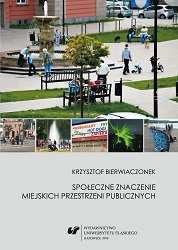Społeczne znaczenie miejskich przestrzeni publicznych
The Social Importance of Urban Public Spaces
Author(s): Krzysztof Bierwiaczonek
Subject(s): Anthropology, Social Sciences, Psychology, Geography, Regional studies, Regional Geography, Sociology, Rural and urban sociology
Published by: Wydawnictwo Uniwersytetu Śląskiego
Keywords: public space; city; place; spatial identity; spatial value
Summary/Abstract: The starting point for the observations made in the monograph The Social Importance of Urban Public Spaces is the claim that if one wants to speak of the city these days as something more than just an administrative, demographic and economic structure, it is necessary to provide public spaces in which the denizens of the city could experience interaction both with other people as well as with the urban space itself. The way in which the inhabitants of the city interact with and confront the urban public spaces becomes, therefore, a singularly interesting research topic. It is, in fact, a multifaceted process, closely connected with both the everyday functioning in those spaces as well as the reflection upon their significance for the city or their role in creating the urban and subjective identity. The aforementioned phenomena are, in turn, connected with the varying manners of experiencing and defining the public space. The experience of the urban public space constitutes the primary research topic. In order to conduct the analysis of that experience, the author assumed the culturalist perspective, traditional for social sciences, which assumes the analysis of the social reality from the perspective of an individual. In light of that, the urban public space has been defined as an area in the city which is accessible, appealing, facilitating contact with other users of the city, aesthetic, and one which invites the people to meet, act and feel safe.The research findings analysed in this monograph come from 2012, when the preliminary research was conducted in three cities in the Upper Silesia: Jastrzębie-Zdrój, Tychy, and Żory. In each of those cities, the research sample averaged over 300 respondents. Overall, 982 people were asked to take part in the research conducted with the help of a questionnaire. In the monograph, the author compares those results with earlier results of research conducted in Katowice and Gliwice by the author himself, or with cooperation with other researchers. The use of that data, alongside the most recent research findings, allows to come to more general conclusions which go beyond the scope of case studies. The collected data allowed to formulate several conclusions regarding the social experience of urban public spaces. It is possible to enumerate in each city a number of spaces which are considered by the inhabitants to be good public spaces. Those usually entail marketplaces or other squares located in the city centre, as well as attractive recreational spaces and parks.From the perspective of the inhabitants of the cities and the users of public spaces, the mostimportant feature of such spaces is their multifunctionality, which allows their users to conduct various activities. This, in turn, epitomises the importance of marketplaces, squares and parks. The latter are, in turn, particularly important for the recreational activities conducted within the urban public spaces, as they constitute important locations in which people decide to spend their leisure time. Thus, both parks and other urban public spaces remain in direct competition with people’s homes as well as other places located outside of the city boundaries.Even though the research did not point to any elements which could be classified as “thefear of the urban space,” the inhabitants of the cities in question are charaterised by significantsocial passivity. Over 30% of respondents do not participate in freely available events which take place in urban public spaces. The only events which manage to attract larger percentages of the city inhabitants are fairs, free concerts and religious events. Social, political or civil activities do not constitute an important way of interacting with the urban space.On the basis of the theory of spatial value, a claim has been made that city centres, even inthose cities in which those centres are either lacking or difficult to establish, evoke for the most part more positive associations than shopping malls, which, for the majority of respondents, are bland and described usually in terms of shopping arrangements. Therefore, echoing the concept of spatial value, coined by Florian Znaniecki, and the division of values, coined by Aleksander Wallis, it would be possible to consider city centres to possess existential spatial values, while shopping malls posses only functional spatial values.Such spaces influence the identity of the subjects, to a certain degree, particularly that structure of it which could be called after Peter Weichhart individual spatial identity. Despite a high level of identification with the city and its inhabitants, there exists only a minority of the city inhabitants which declare that they do posses a space which would strengthen their relationship with the city, i.e. facilitate the creation of individual spatial identity.On the basis of the research findings presented in this monograph, it would be possible todifferentiate between six social roles of urban public spaces: functional, interactive, symbolic,axiological, identical and civic. Their significance in contemporary cities varies on a case by case basis. From the perspective of the city inhabitants, the functional role remains the most important, while the civic role is considered the least important.
Series: Nauki społeczne
- E-ISBN-13: 978-83-8012-957-3
- Print-ISBN-13: 978-83-8012-956-6
- Page Count: 260
- Publication Year: 2016
- Language: Polish
- eBook-PDF
- Table of Content
- Introduction

